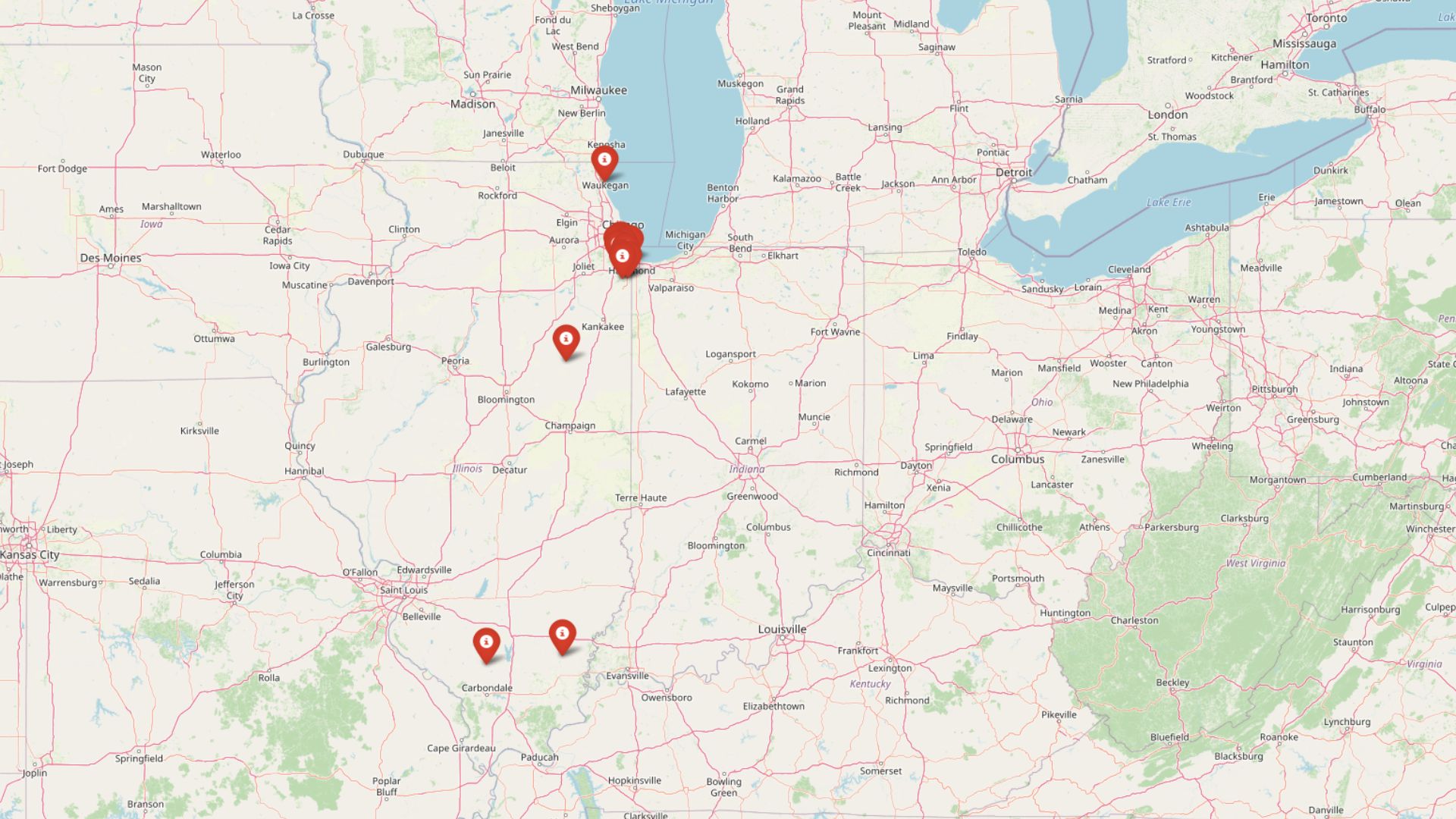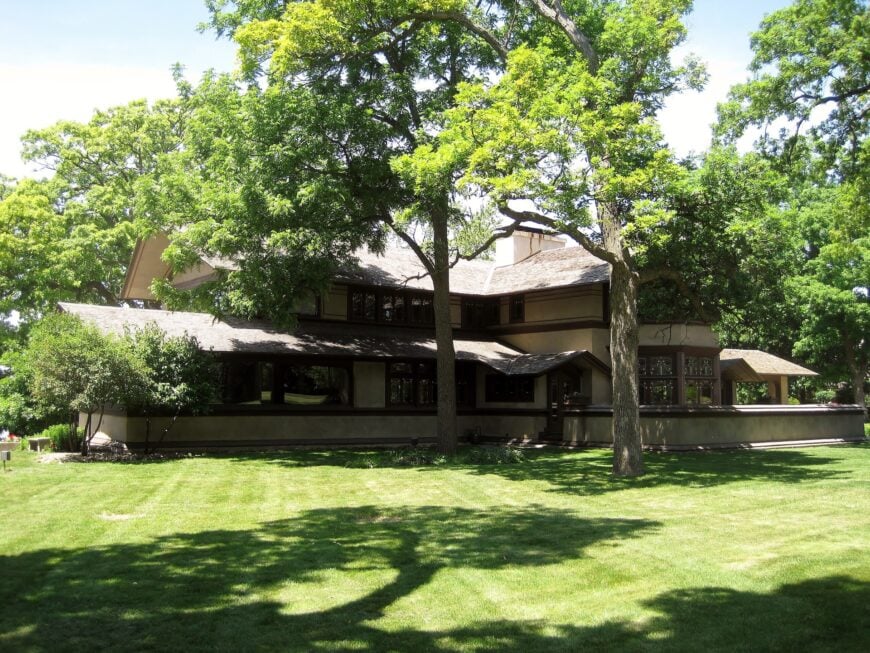
Architect Frank Lloyd Wright realized his ideas in everyday places. While Oak Park and Chicago often take the spotlight, it’s the small towns that hold some of his most revealing work. In places like Kankakee, Rockford, Geneva, and Marion, Wright experimented, revised, and tested out designs that would shape his legacy. These aren’t museum pieces. They’re lived-in homes, quiet banks, and modest chapels that still sit within working neighborhoods and down unassuming streets.
Illinois became Wright’s testing ground for a reason. Born in Wisconsin and based in Chicago during key points in his career, Wright stayed anchored to the Midwest. The region’s flat landscapes, strong community ties, and practical building materials shaped how he thought. These towns—La Grange, Elmhurst, Aurora—offered clients who were willing to try something new. They asked for homes that fit their lives but carried something extra: purpose, vision, a sense of design that looked ahead rather than around.
Some projects, like the Laurent House in Rockford, pushed accessibility before the term existed. Others, like the B. Harley Bradley House in Kankakee, helped define the Prairie School’s broad horizontals and stained-glass geometry. Even in a small town like Belvidere, the open-air Pettit Chapel carries the unmistakable Wright vocabulary—clean lines, intentional space, and a respect for the surrounding environment.
This guide follows 15 towns across Illinois where Wright’s presence remains part of the daily landscape. It’s less about grand tours and more about attention: to how design fits into real life, and how one architect managed to leave his fingerprint on places that never asked for a spotlight. The homes are still here. So are the streets, the sidewalks, and the people who’ve built their lives around them.
15. Marion, IL – Visit the Impressive Rathje House Amid Southern Charm
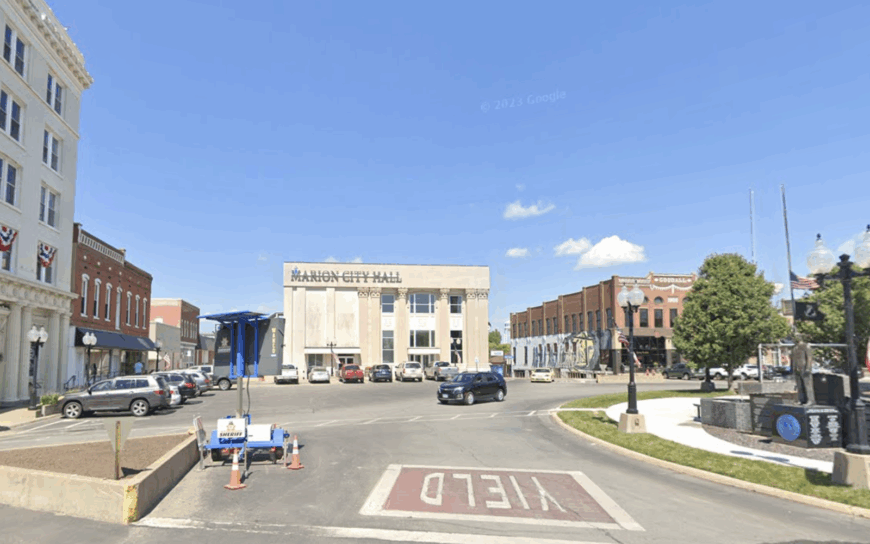
Marion’s tree-lined streets conceal an unexpected Wright treasure in the Rathje House, a late-career Usonian design completed in 1951. The compact brick dwelling showcases board-and-batten walls, built-in furniture, and clerestory windows that flood the interior with southern Illinois sunlight.
Visitors can arrange private tours through the current caretakers, gaining insight into Wright’s quest for affordable yet beautiful housing. While in town, travelers often linger around Tower Square Plaza, where local artisans sell pottery and homemade pralines on weekends.
Crab Orchard National Wildlife Refuge sits only a short drive away, offering kayaking routes. Evenings end nicely at one of Marion’s supper clubs, many of which still carry the retro ambiance Wright himself might have appreciated.
Marion offers 3-4 bedroom homes priced between $150,000 and $450,000, making it an accessible choice for architecture enthusiasts.
Where is Marion?

Marion rests in Williamson County, about 20 miles east of the Mississippi flyway and just off Interstate 57. The town’s location on the edge of the Shawnee Hills means rolling terrain replaces the flat prairies most people associate with Illinois.
Amtrak’s Saluki and Illini trains stop in nearby Carbondale, and from there, a quick rideshare reaches the town in under 30 minutes. Drivers find the trip straightforward, with Exit 54 delivering them to downtown and the discreet residential lane that hides Wright’s work.
14. Aurora, IL – Explore Wright’s Works in a Historic Yet Intimate City

Aurora, often called the “City of Lights” for its early adoption of electric street lamps, also glows with Wright’s Harold C. and Mary Blair House from 1909. The Prairie style residence features low-pitched roofs and art-glass windows that echo the Fox River meandering through town.
Architecture buffs combine a tour of the Blair House with a walk across Stolp Island to admire mid-century storefronts. Aurora’s Paramount Theatre stages Broadway-quality shows, filling an afternoon or evening after house-hopping.
Outdoor enthusiasts sail at nearby Mastodon Lake, a calm respite framed by restored prairie plantings. Coffee drinkers should hunt for Tredwell Coffee, an independent roaster tucked inside a historic bank building.
Aurora’s 3-4 bedroom houses typically range from $200,000 to $500,000, blending suburban comfort with historic charm.
Where is Aurora?
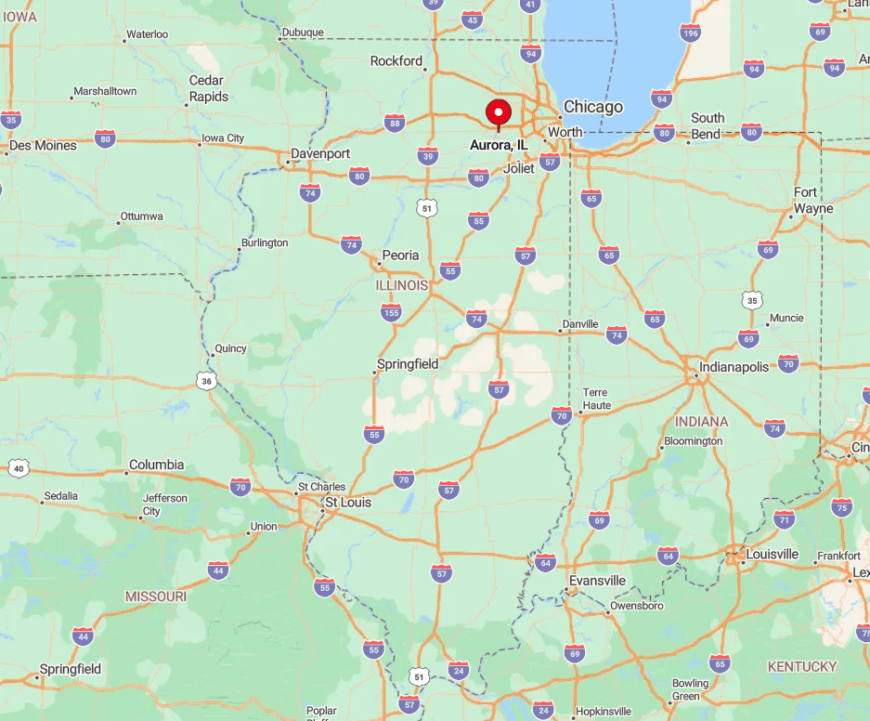
Aurora sits 40 miles west of Chicago along the BNSF Railway corridor. Metra trains from Union Station whisk visitors to downtown in roughly an hour, dropping them within walking distance of the Blair House.
The city straddles both sides of the Fox River, adding waterfront vistas unusual for an inland Illinois community of this size. Drivers access Aurora via I-88, then follow well-marked heritage tourism signs to the house on West Downer Place.
13. Rockford, IL – Uncover Wright’s Laurent House in a Riverside Setting

Rockford’s Laurent House stands apart as Wright’s only design created specifically for a wheelchair client, completed in 1952. The single-story hemicycle plan wraps around a patio, revealing Wright’s sensitivity to mobility decades before universal design became common.
Guided tours explore original Herman Miller furnishings, a built-in copper fireplace hood, and level thresholds throughout. Beyond architecture, Rockford surprises guests with the lush Anderson Japanese Gardens, often ranked among the top in North America.
The city’s Riverwalk links microbreweries to sculpture installations, making for an easy afternoon. Locals recommend the Norwegian, a Scandinavian cafe that pairs open-face sandwiches with stories about Wright’s meetings in the 1950s.
Rockford features 3-4 bedroom homes priced between $180,000 and $480,000, perfect for those drawn to cultural heritage and community living.
Where is Rockford?
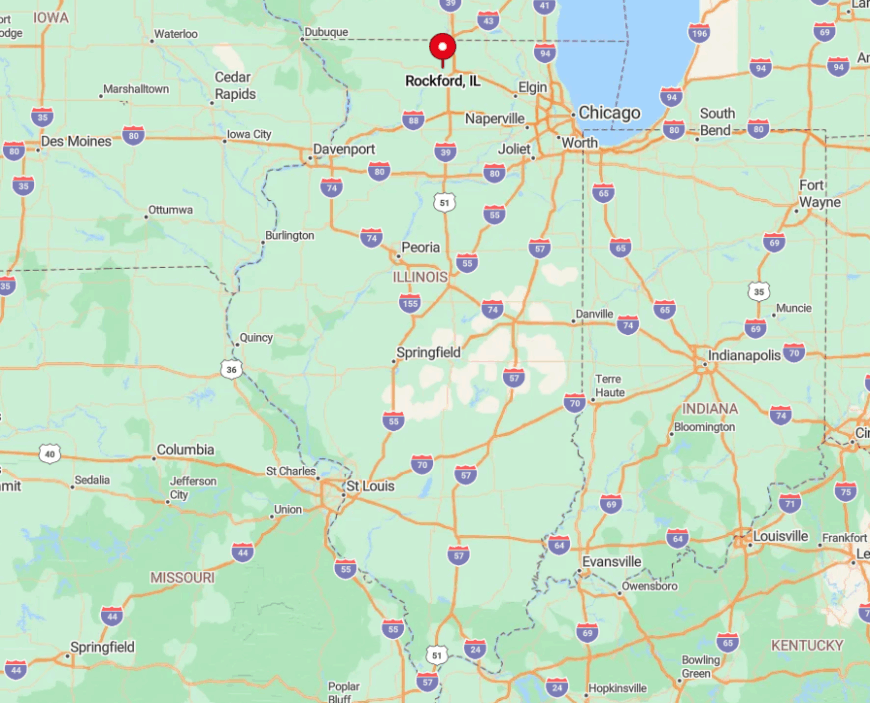
Rockford lies along the Rock River in northern Illinois, about 90 minutes northwest of Chicago via I-90. The Laurent House occupies a quiet suburban lot on Spring Brook Road, shielded by mature oaks accentuating its curved façade.
Chicago Rockford International Airport offers limited commercial flights, but most travelers arrive by car using the Jane Addams Memorial Tollway. Ample parking makes self-guided exploration easy, and bicycle lanes connect the site to downtown for car-free visitors.
12. Peoria Heights, IL – Experience Wright’s Modern Marvel, the Petit Residence
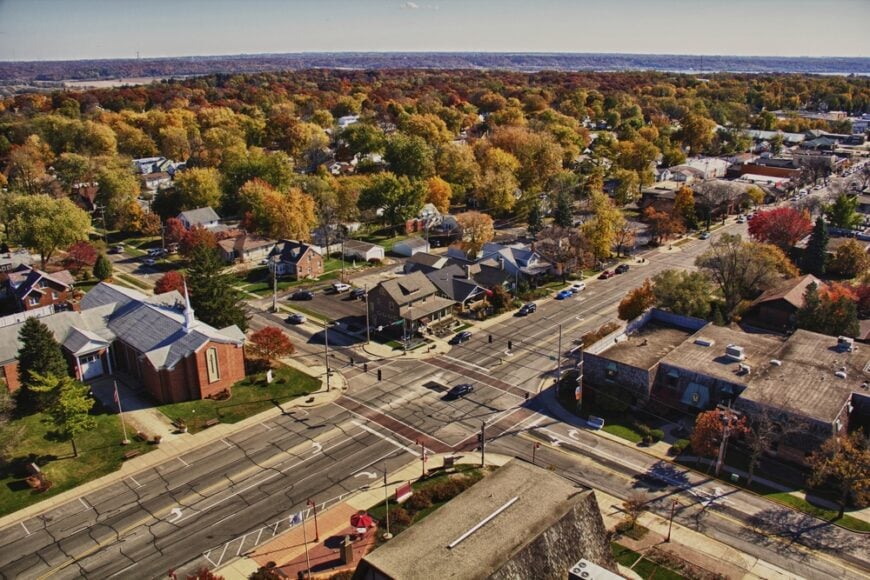
Perched on a bluff above the Illinois River, Peoria Heights hosts the rarely mentioned C. Louis Petit Residence, a 1953 Wright design blending brick, glass, and copper fascia. The home’s elongated rectangle follows the ridge, granting panoramic water views Wright punctuated with ribbon windows.
Tours can be arranged through the Fine Arts Society, which often pairs them with wine tastings at local vineyards. Prospect Road is the community’s main drag, with boutiques selling river-inspired art and vintage vinyl.
A short hike in Forest Park Nature Preserve reveals limestone outcrops that mirror the house’s horizontal emphasis. Nightfall brings visitors to Heritage Plaza, where a 1920s water tower doubles as an observation deck for sunsets.
Peoria Heights offers 3-4 bedroom houses in the $180,000 to $480,000 range, ideal for buyers seeking scenic views and small-town warmth.
Where is Peoria Heights?
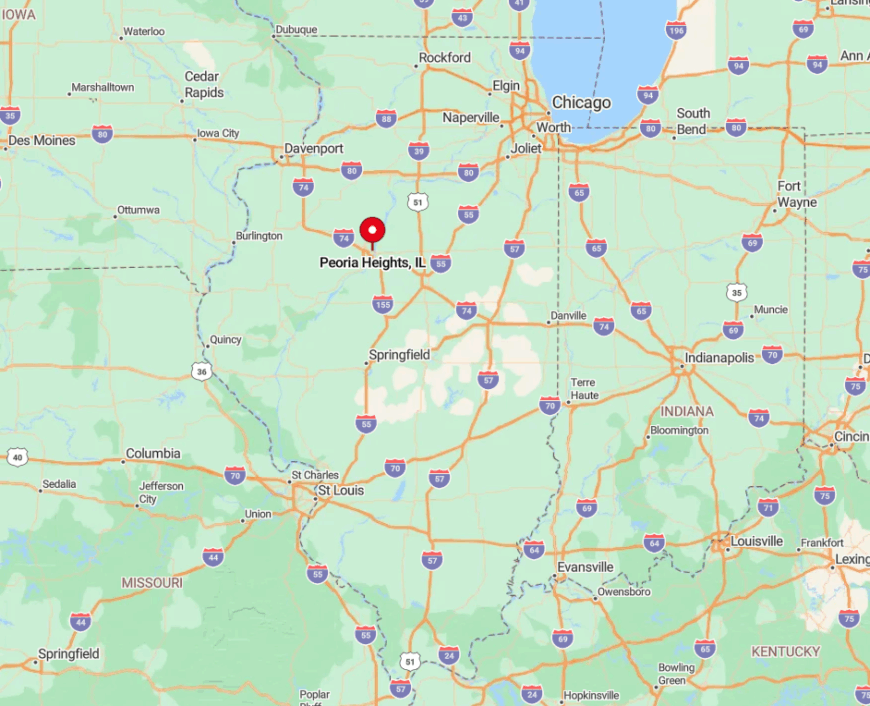
Peoria Heights borders the city of Peoria but retains its own village identity. It is roughly midway between Chicago and St. Louis on Interstate 74. Its elevated position along the river valley provides unusual topography for central Illinois, making the Petit Residence feel like a treehouse.
Peoria International Airport is 14 miles away, and ride-share drivers usually drop guests off at the private driveway. Those using public transit can ride CityLink bus No. 4 to Prospect Road, then walk ten minutes uphill to reach the site.
11. Elmhurst, IL – Discover Wright’s Architectural Influence in a Cultural Hub

Elmhurst balances suburban comfort with cultural buzz, anchored by Wright’s 1901 F.B. Henderson House on South Kenilworth Avenue. The structure’s broad eaves and art-glass windows preview motifs Wright perfected later at Taliesin.
Docents point out original pocket doors that slide quietly behind oak trim, a detail often missed in photographs. After the tour, museum lovers wander to the Elmhurst Art Museum, which includes a glass pavilion designed by Mies van der Rohe protégé Dan Wheeler.
Wilder Park Conservatory offers a peaceful orchid room, providing a nice architectural palate cleanser. Hungry visitors find global flavors along York Street, with Nu Crepes serving strawberry-basil creations only locals seem to know.
Elmhurst boasts 3-4 bedroom homes priced between $250,000 and $550,000, combining vibrant neighborhoods with rich architectural history.
Where is Elmhurst?
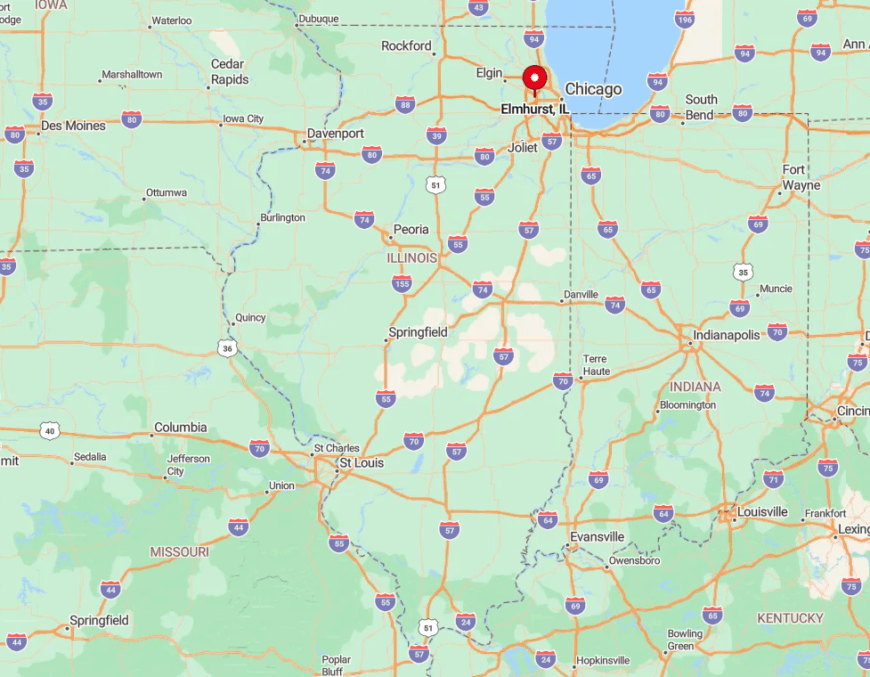
Elmhurst sits 17 miles west of downtown Chicago, neatly placed along the Union Pacific West Metra line. Trains deposit passengers two blocks from the Henderson House, making this one of the easiest Wright sites to reach without a car.
O’Hare International Airport is a 20-minute drive, and taxis usually take Route 83 to bypass tollways. Even drivers appreciate the town’s grid, where plentiful street parking and wide lanes echo the horizontal forms Wright admired.
10. Wilmette, IL – Appreciate the Prairie Style in a Coastal Village
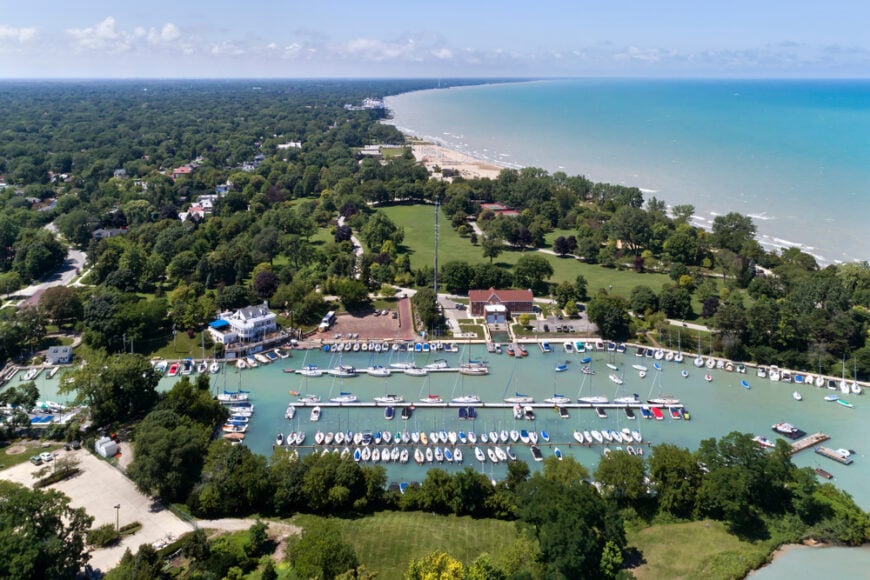
Hugging the Lake Michigan shoreline, Wilmette hosts the William H. Emery Jr. House, a 1903 Prairie masterpiece with diamond-pattern art glass. The residence sits among mature elms, its low roofline visible beyond sculpted hedges that maintain privacy without hiding beauty.
Tours often begin at the stone-arched entry, where guides highlight the rare use of a raised terrace overlooking the garden. While in town, guests usually walk east to Gillson Park for lake views and a chance to discuss Wright’s nautical inspirations.
Central Avenue’s French Market pops up on Saturdays, selling lavender honey and ceramics that fit comfortably in any kitchen. Less known is the Baháʼí House of Worship, whose white concrete offers a counterpoint to Wright’s earth-tone palette.
Wilmette’s 3-4 bedroom homes cost between $300,000 and $600,000, appealing to those who appreciate a blend of nature and elegant design.
Where is Wilmette?
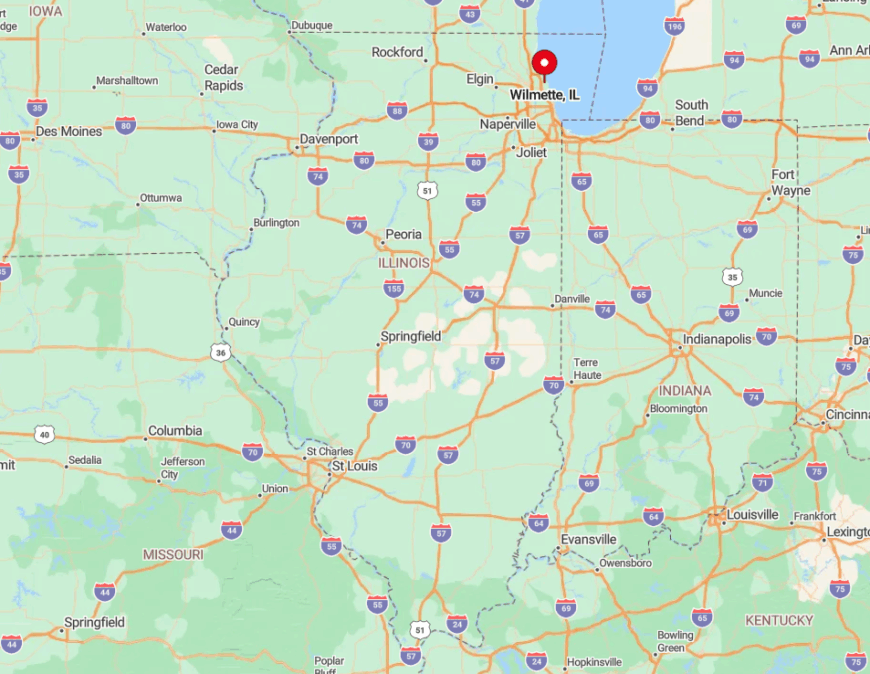
Wilmette belongs to Chicago’s North Shore, 15 miles from the Loop via Lake Shore Drive and Sheridan Road. The village’s lakefront bluffs create subtle elevation changes, allowing the Emery House to perch slightly above neighboring lots.
Metra’s Union Pacific North line and the CTA Purple Line stop within walking distance, so car-free travel is painless. Drivers should note on-street parking rules, but will find ample spaces along Forest Avenue steps from the house.
9. La Grange, IL – Explore a Cluster of Wright Homes in a Vibrant Locale
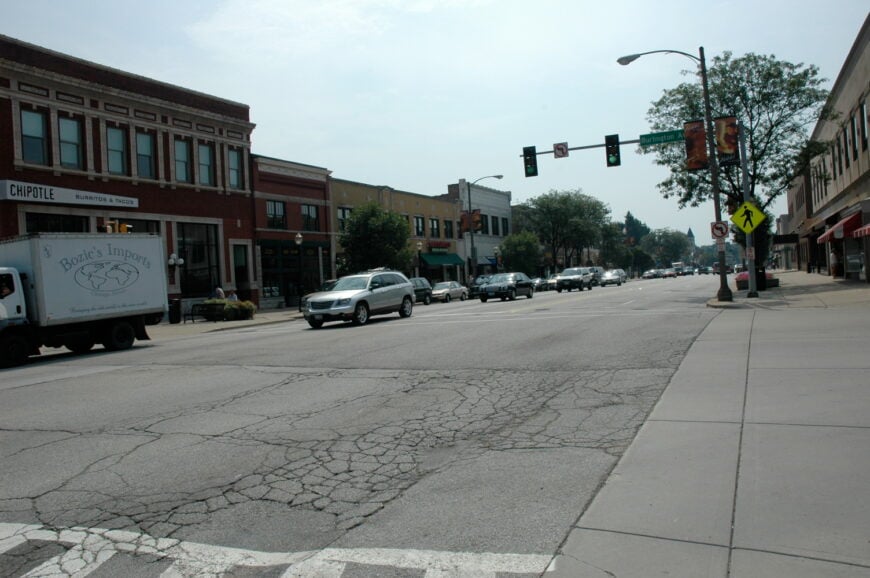
La Grange packs an impressive cluster of Frank Lloyd Wright homes, including the Peter Goan House and the thrillingly angular C. C. Willetts House. The proximity allows architecture fans to stroll tree-shaded blocks and spot multiple Wright facades within an hour.
After house hunting, downtown’s Stone Avenue Station hosts live jazz in a restored 1901 waiting room. La Grange’s dining scene excels, especially at Prasino, where farm-to-table plates echo Wright’s devotion to local materials.
Adventurers rent bicycles at the commuter hub and follow the Salt Creek Trail to Brookfield Zoo. A little-known bonus is the Vintage Market held every third Sunday, featuring salvaged Prairie School light fixtures.
La Grange offers 3-4 bedroom houses in the $250,000 to $550,000 range, perfect for lovers of classic architecture and community spirit.
Where is La Grange?
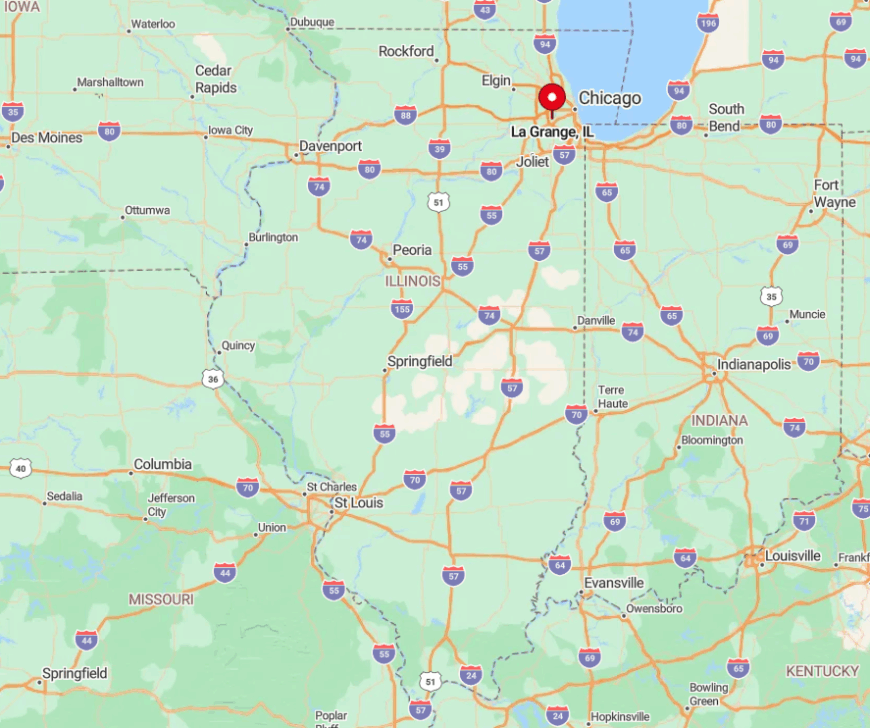
La Grange is 13 miles southwest of Chicago and conveniently served by the BNSF Metra line. The village’s grid centers on La Grange Road, making self-guided walking tours simple.
Drivers exit I-55 at La Grange Road or take Ogden Avenue, connecting to residential streets housing Wright gems. The flat terrain allows even casual cyclists to cover every site in an afternoon.
8. Kenilworth, IL – Admire Wright’s Residential Designs in an Exclusive Enclave
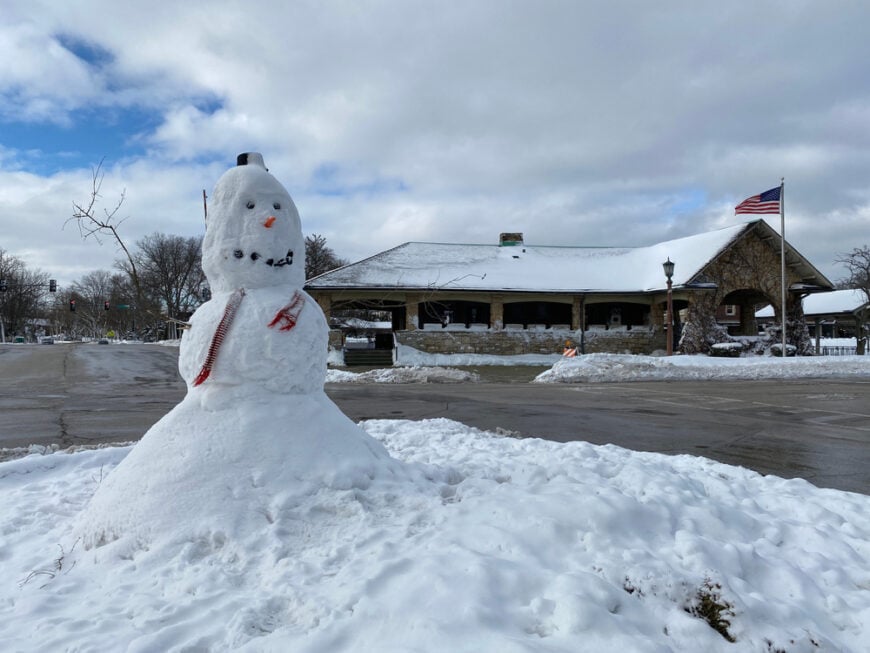
Kenilworth exudes quiet affluence, and within its manicured lawns sit two Wright residences: the 1906 H. F. Johnson House and the George W. Smith House. These homes display elongated brick chimneys and generous overhangs that nod to the expansive Lake Michigan horizon nearby.
Tours are limited, but keen observers appreciate exterior lines from public sidewalks shaded by towering maples. Afterward, many visitors explore the Kenilworth Beach, a pocket of sand locals guard lovingly.
History buffs also duck into the Kenilworth Historical Society, housed in a 1922 railway station with exhibits on suburban planning that Wright praised and critiqued. Kenilworth features 3-4 bedroom homes priced between $400,000 and $700,000, reflecting its status as a refined and historic enclave.
Where is Kenilworth?
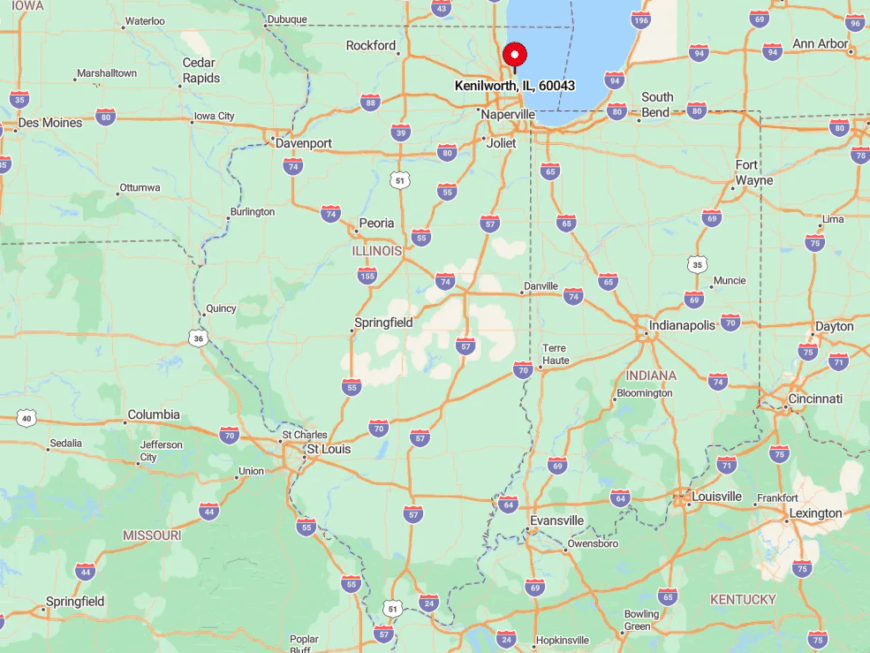
Kenilworth sits 16 miles north of Chicago, directly on Metra’s Union Pacific North Line. Sheridan Road threads through the village, giving drivers lake glimpses before turning onto Kenilworth Avenue for Wright sightseeing.
The village’s compact size makes all points walkable, although parking regulations require attention. Cyclists often combine Kenilworth with nearby Winnetka sites along the Green Bay Trail.
7. Belvidere, IL – Find Tranquility at the Pettit Memorial Chapel
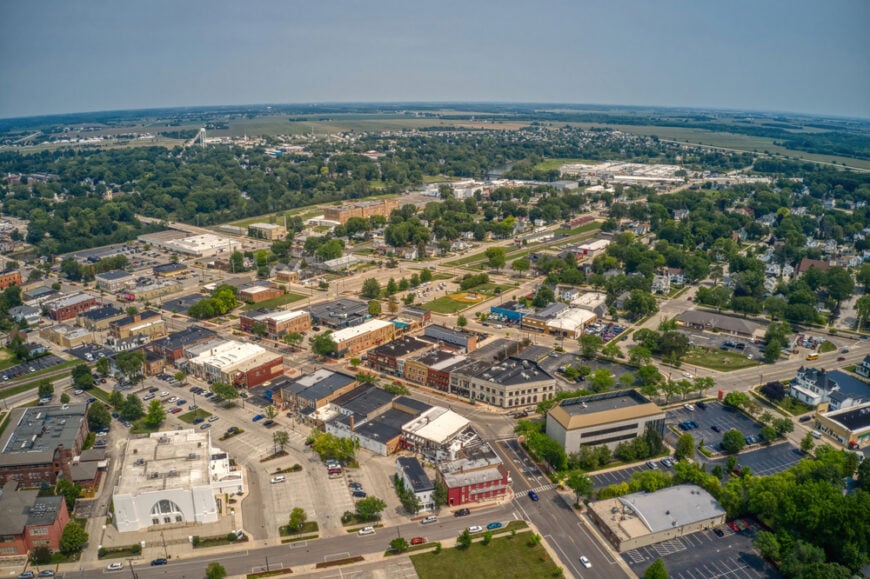
Belvidere’s crown jewel for Wright aficionados is the Pettit Memorial Chapel, built in 1906 in the calm of Greenwood Cemetery. The modest open-air structure uses limestone piers and a butterfly roof to create an intimate space for reflection.
Visitors can picnic on the chapel lawn, listening to the Kishwaukee River that murmurs just beyond the cemetery gates. Downtown Belvidere surprises travelers with wall-spanning murals depicting automotive heritage and prairie flora.
The Boone County Museum of History showcases an original 19th-century log cabin, offering context for Wright’s modernity. For dessert, the Dari Ripple stand on Logan Avenue dishes out orange sherbet twists, a local tradition since 1957.
Belvidere offers 3-4 bedroom houses between $150,000 and $450,000, making it an affordable option with cultural appeal.
Where is Belvidere?
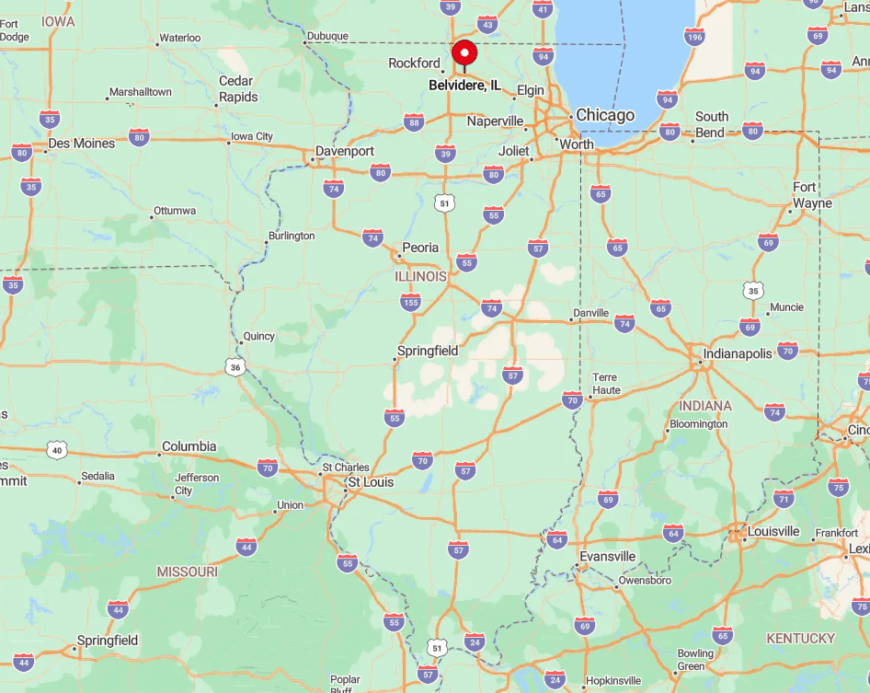
Belvidere lies 75 miles northwest of Chicago along I-90, just east of Rockford. The chapel sits on the cemetery’s west edge, where Wright oriented the open pavilion toward sunset.
Limited public transit reaches the town, so most guests arrive by car and park along River Drive. The short distance between downtown and the cemetery makes it easy to pair architectural and culinary exploration.
6. Hampshire, IL – Discover the Muirhead Farmhouse in Peaceful Countryside
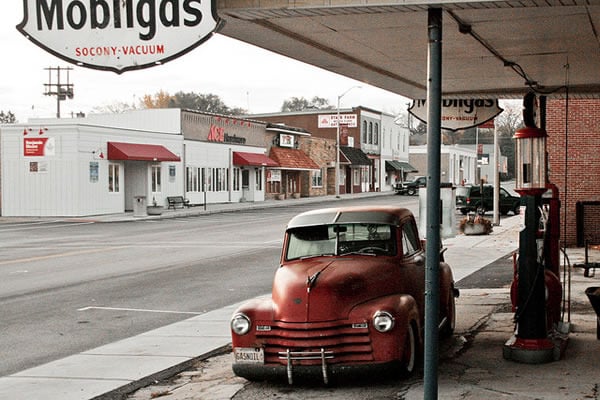
In rural Kane County, the Muirhead Farmhouse of 1951 demonstrates Wright’s take on agricultural living. The elongated Usonian structure embraces 79 acres of corn and soy fields, making the horizon a key design element.
Guided tours include a hay-wagon ride that illustrates how Wright planned sightlines from the kitchen to the barn. Visitors often add a stop at Hampshire Forest Preserve for prairie walks filled with blazing stars and monarch butterflies.
Downtown Hampshire keeps things simple with a single stoplight, a classic soda fountain, and a Saturday tractor parade each July. Photographers love the sunrise at the farmhouse, when low light paints the Cherokee red masonry.
Hampshire’s 3-4 bedroom homes range from $180,000 to $480,000, offering buyers a peaceful suburban setting with architectural flair.
Where is Hampshire?
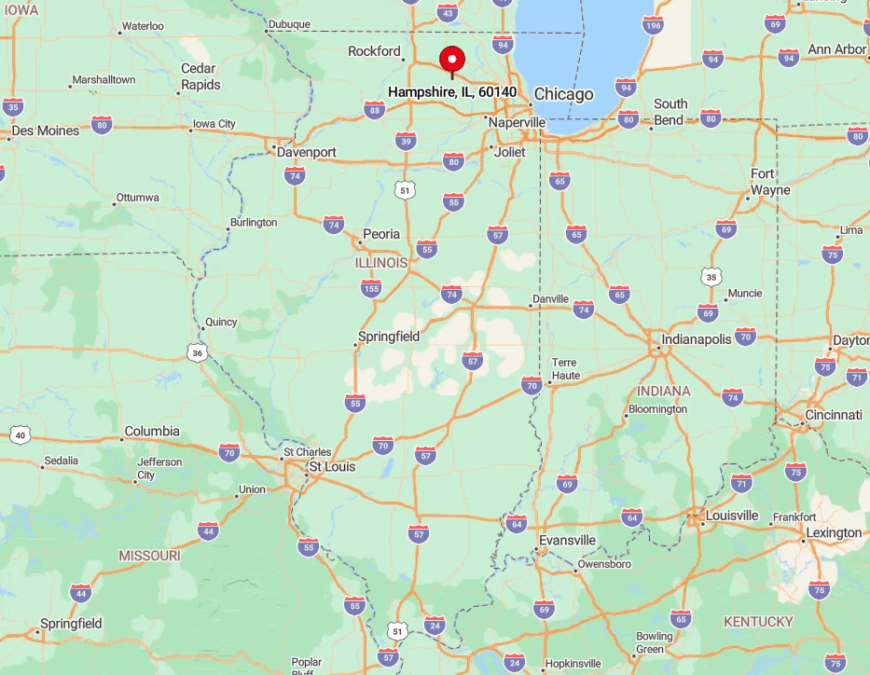
Hampshire is five miles north of Interstate 90, roughly halfway between Elgin and DeKalb. The farmhouse sits on Burlington Road, a quiet two-lane route lined with silos and windbreaks.
Chicago visitors can combine Metra’s Milwaukee District West train to Elgin with a scheduled shuttle arranged through the house trustees. Plenty of gravel parking awaits just beyond the farm gate for those arriving by car.
5. Dwight, IL – Visit the Iconic Frank L. Smith Bank in a Quaint Village
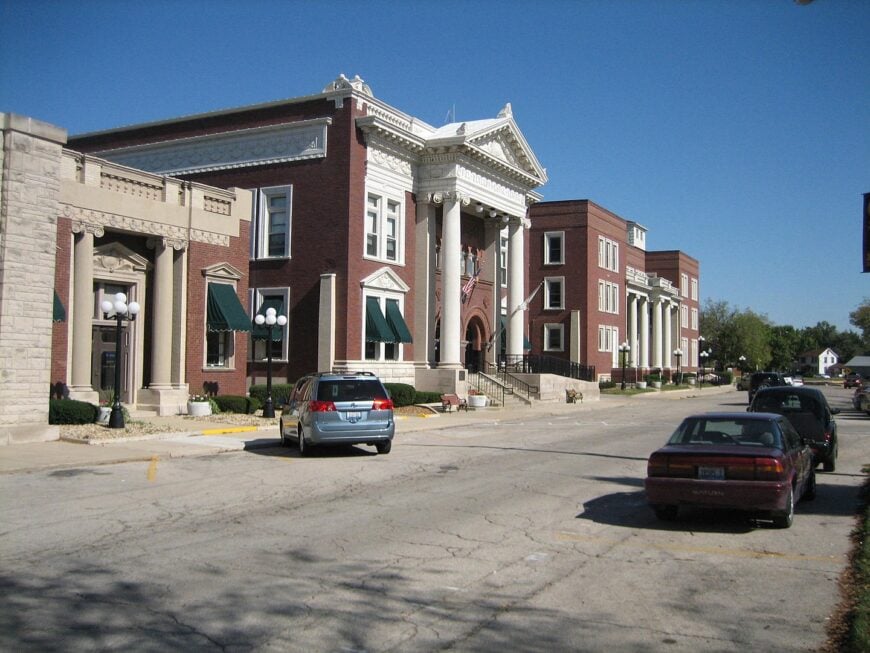
Dwight surprises Route 66 travelers with Wright’s Frank L. Smith Bank, a small but striking 1905 building at Main and Franklin. The Roman brick façade, adorned with horizontal stone bands, contrasts sharply with the town’s Victorian storefronts.
Inside, green-tinted skylights cast an otherworldly glow on the polished oak counters. After viewing the bank, many guests tour the Oughton Estate windmill or snap photos of the vintage Ambler Texaco gas station.
Antique hunters browse Renfrew Park’s seasonal flea markets, often uncovering Arts and Crafts light fixtures. Dwight features 3-4 bedroom houses priced between $150,000 and $450,000, ideal for those seeking charm and community.
Where is Dwight?
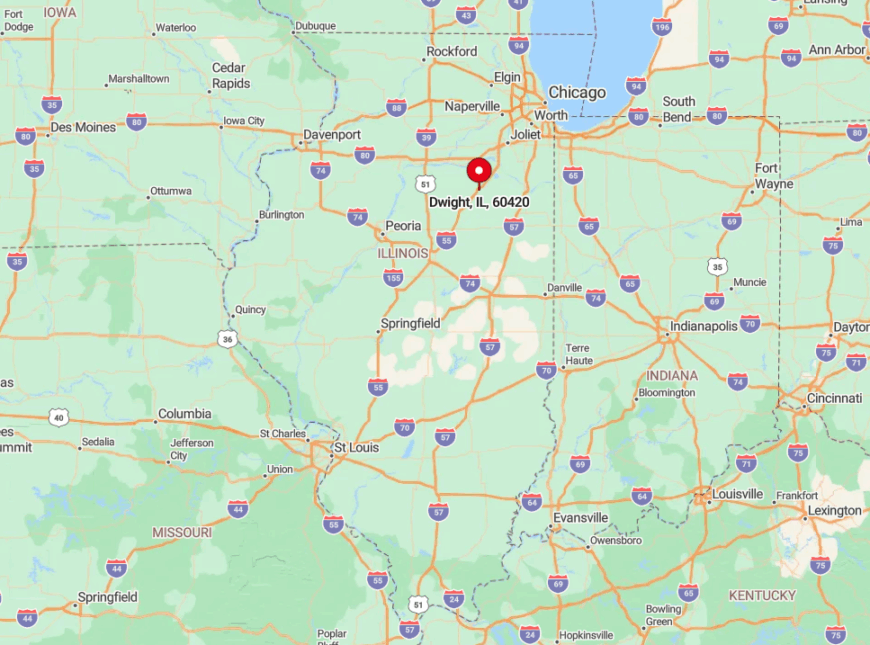
Dwight sits 80 miles southwest of Chicago at the junction of I-55 and historic Route 66. The town gently rose above the Vermilion River, a setting that gave Wright natural drainage for his bank’s basement archives.
Amtrak’s Lincoln Service stops daily, leaving travelers a two-block walk to the bank. Drivers find plentiful street parking and clear signage pointing toward the bank and Route 66 landmarks.
4. Geneva, IL – Uncover the M.A. Heun House Amidst Historic Charm

Geneva’s brick sidewalks lead to the 1906 M.A. Heun House, a Wright design tucked among Queen Anne neighbors on Peyton Street. The residence features a crenellated parapet and leaded art-glass windows that catch dappled light from towering maples.
Visitors often combine a photo stop with a stroll along the Fox River Trail, where bald eagles fish in winter. Geneva’s Third Street teems with boutiques like The Little Traveler, a 36-room shop housed in a 19th-century mansion.
Each June, the Swedish Days Festival fills the town with folk dancers and pastry scents, lending an international flavor to Wright appreciation. Geneva’s 3-4 bedroom homes typically cost between $250,000 and $550,000, perfect for fans of historic homes and lively local culture.
Where is Geneva?
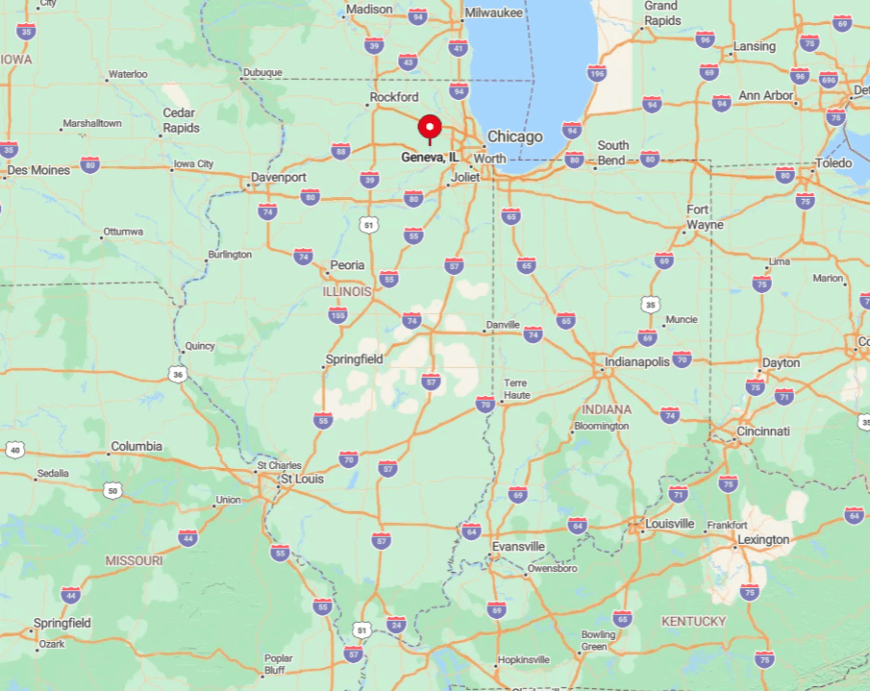
Geneva is 40 miles west of Chicago and easily reached by Metra’s Union Pacific West line. The Heun House sits less than a half mile from the station, making a car unnecessary.
The Fox River slices through town, creating gentle slopes that Wright accentuated with his terrace design. Drivers on Route 38 find clear historic district signage leading them directly to Peyton Street.
3. Glencoe, IL – Experience Wright’s Ravine Bluffs Development in a Lakeside Haven

Glencoe hosts the Ravine Bluffs Development, a collection of six Wright homes constructed in 1915 for poet and attorney Sherman Booth. The enclave includes a striking concrete bridge still carrying traffic across a ravine, proving Wright’s engineering chops.
Walking tours reveal how each house steps down the wooded hillside, preserving privacy while framing lake breezes. After the walk, many visitors picnic at Glencoe Beach, whose sandy stretch feels worlds away from Chicago.
The Chicago Botanic Garden sits just south, offering 385 acres of inspiration. Hidden in plain sight is Writers Theatre, whose lobby windows align with the same trees that cradle the Booth Cottage.
Glencoe offers 3-4 bedroom houses priced between $300,000 and $600,000, blending upscale living with architectural significance.
Where is Glencoe?
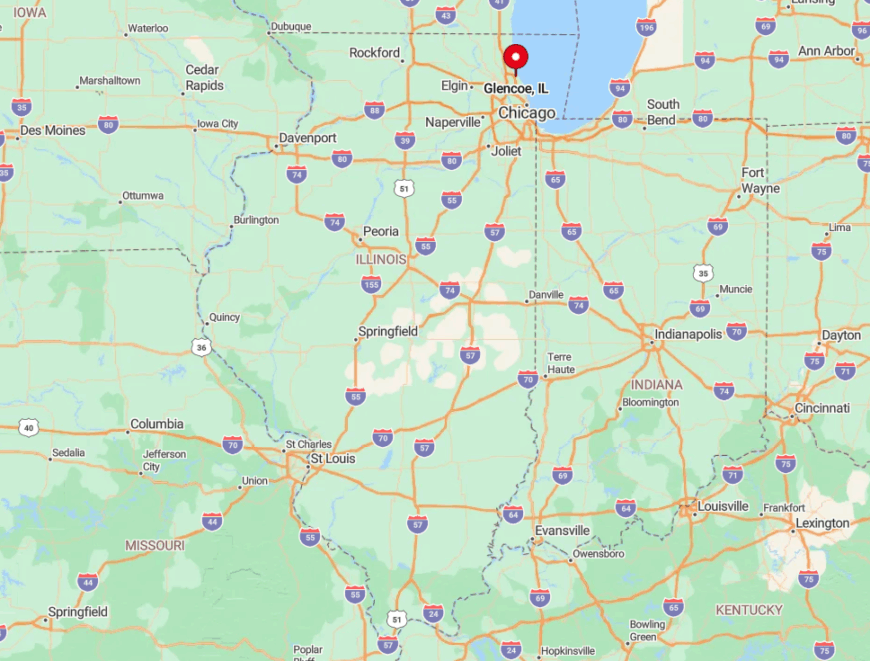
Glencoe lies 20 miles north of Chicago, between Lake Michigan and the Skokie Lagoons. Metra’s Union Pacific North line stops two blocks from the development, and bike rentals outside the station make for an easy ride.
Sheridan Road winds scenically into town, giving drivers glimpses of century-old mansions before curving toward Franklin Road and the Ravine Bluffs entrance. The ravines add dramatic elevation changes uncommon in the generally flat region, enhancing Wright’s stepped designs.
2. River Forest, IL – Stroll Through a Village Adorned with Wright’s Masterpieces

River Forest may be small, yet its leafy avenues host no fewer than ten Wright homes, including the celebrated Winslow House just over the village border. The community’s building boom in the 1890s coincided with Wright’s early career, making it a living catalog of his progression.
Guided walking tours originate at the Thatcher Avenue Train Depot, where volunteers provide illustrated maps. Cyclists appreciate the nearby Illinois Prairie Path, a rail-trail cutting through oak savannas Wright would have admired.
Architecture students often linger to sketch the River Forest Tennis Club, whose shingled roof allegedly influenced Wright’s residential proportions. River Forest boasts 3-4 bedroom homes ranging from $350,000 to $650,000, reflecting a neighborhood rich in heritage and style.
Where is River Forest?

River Forest borders Oak Park, seven miles west of Chicago’s Loop and accessible via the CTA Green Line and Metra’s Union Pacific West line. The Des Plaines River shapes the village’s western boundary, providing floodplain vistas that Wright incorporated into house siting.
Drivers exit I-290 at Harlem Avenue and find plentiful street parking along Lake Street near the historic district. Compact block lengths allow visitors to see multiple Wright homes in an afternoon without moving the car.
1. Kankakee, IL – Explore Wright’s Early Prairie Designs Along the Kankakee River
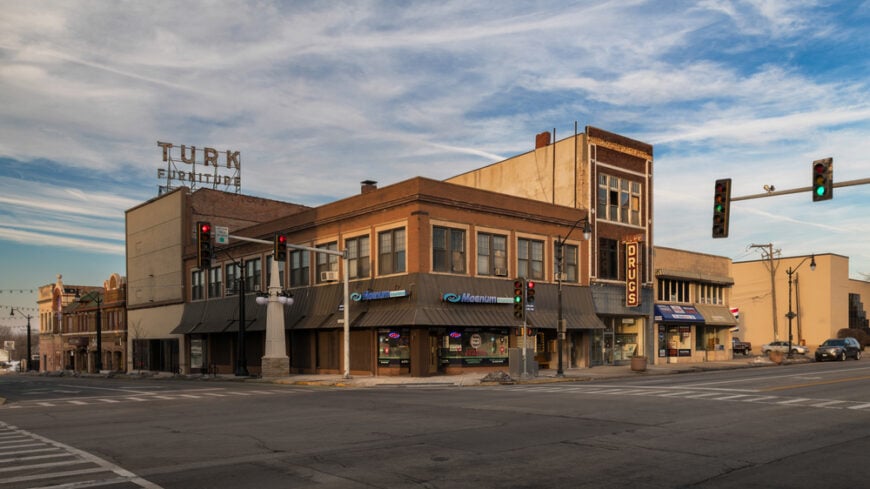
Topping our list, Kankakee offers two early Prairie gems completed in 1900: the B. Harley Bradley House and the Warren Hickox House. The Bradley House, a sprawling riverfront residence, boasts over 90 art-glass windows depicting sumac motifs.
Tours include access to the restored stables, one of Wright’s earliest outbuildings. The neighboring Hickox House remains a private home, but respectful admirers can view its dramatic cantilevered porch from the sidewalk.
After architectural sightseeing, many visitors rent kayaks at the nearby state park and paddle past limestone cliffs. Evening entertainment might include a performance at the historic Majestic Theatre.
Kankakee’s 3-4 bedroom homes range from $150,000 to $450,000, providing an affordable gateway to historic architecture and small-town living.
Where is Kankakee?
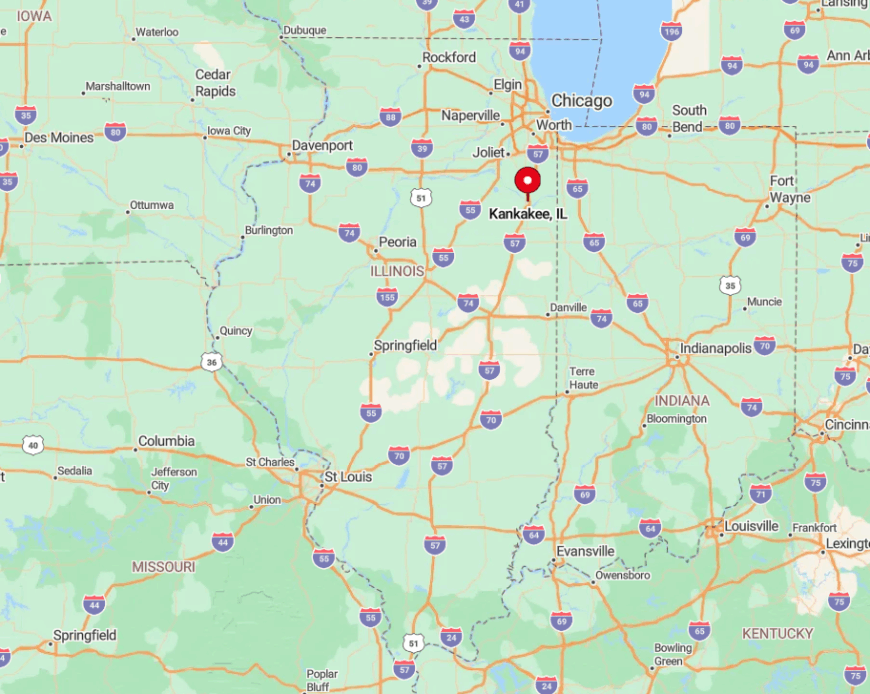
Kankakee sits 60 miles south of Chicago, hugging the bend where the Kankakee River curves east toward the Illinois River. The Bradley House occupies an acre of riverside lawn off South Harrison Avenue, benefiting from cooling breezes Wright harnessed with strategic casement windows.
Amtrak’s Lincoln Service connects Chicago’s Union Station to downtown Kankakee in about an hour, and taxis or a pleasant 15-minute walk lead to the house. Motorists use I-57 to reach Exit 312, then follow marked brown heritage signs to the museum entrance.


